
The Lake District, also known as the Lakes or Lakeland, is a mountainous region and national park in North West England. It is primarily famous for its mountain, lake, and coastal scenery, and for its literary associations with William Wordsworth and other Lake Poets, Beatrix Potter, and John Ruskin.
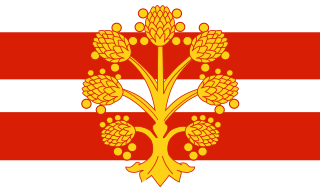
Westmorland was a county in North West England which occupied the southern Lake District and the southern Vale of Eden. It had an administrative function from the 12th century until 1974, when it became part of Cumbria. The people of Westmorland were known as Westmerians.

Kendal, once Kirkby in Kendal or Kirkby Kendal, is a market town and civil parish in the Westmorland and Furness district of Cumbria, England. It lies within the River Kent's dale, from which its name is derived, just outside the boundary of the Lake District National Park.

William Robinson: was an Irish practical gardener and journalist whose ideas about wild gardening spurred the movement that led to the popularising of the English cottage garden, a parallel to the search for honest simplicity and vernacular style of the British Arts and Crafts movement, and were important in promoting the woodland garden. Robinson is credited as an early practitioner of the mixed herbaceous border of hardy perennial plants, a champion too of the "wild garden", who vanquished the high Victorian pattern garden of planted-out bedding schemes. Robinson's new approach to gardening gained popularity through his magazines and several books—particularly The Wild Garden, illustrated by Alfred Parsons, and The English Flower Garden.
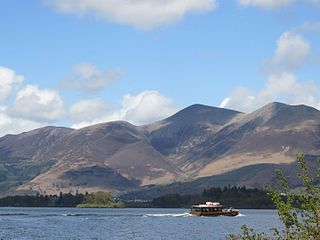
Skiddaw is a mountain in the Lake District National Park in England. Its 931-metre (3,054 ft) summit is the sixth-highest in England. It lies just north of the town of Keswick, Cumbria, and dominates the skyline in this part of the northern lakes. It is the simplest of the Lake District mountains of this height to ascend and, as such, many walking guides recommend it to the occasional walker wishing to climb a mountain. This is the first summit of the fell running challenge known as the Bob Graham Round when undertaken in a clockwise direction.

The University of Oxford Botanic Garden is the oldest botanic garden in Great Britain and one of the oldest scientific gardens in the world. The garden was founded in 1621 as a physic garden growing plants for medicinal research. Today it contains over 5,000 different plant species on 1.8 ha. It is one of the most diverse yet compact collections of plants in the world and includes representatives from over 90% of the higher plant families.

RHS Garden Wisley is a garden run by the Royal Horticultural Society in Wisley, Surrey, south of London. It is one of five gardens run by the society, the others being Harlow Carr, Hyde Hall, Rosemoor, and Bridgewater. Wisley is the second most visited paid entry garden in the United Kingdom after the Royal Botanic Gardens, Kew, with 1,232,772 visitors in 2019.
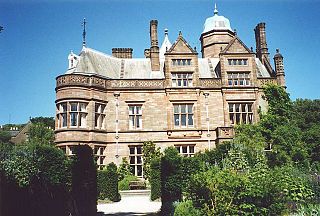
Holker Hall is a privately owned country house located about 2 km to the southwest of the village of Cartmel in the ceremonial county of Cumbria and historic county of Lancashire, England. It is "the grandest [building] of its date in Lancashire ...by the best architects then living in the county." The building dates from the 16th century, with alterations, additions, and rebuilding in the 18th and 19th centuries. The 19th century rebuilding was by George Webster in Jacobean Revival style and subsequent renovations were by E. G. Paley. Hubert Austin had a joint practice with Paley by the 1870s and they both rebuilt the west wing after it was destroyed by a major fire in 1871, only a decade after Paley's previous work on the structure. The fire also destroyed a number of notable artworks. Holker Hall is Paley and Austin's "most important country house commission." The architectural historian Nikolaus Pevsner expressed the opinion that the west wing is the "outstanding domestic work" of Paley and Austin. In 1970 the hall itself, together with its terrace wall, were designated Grade II* Listed buildings. The house stands in an estate of about 80 hectares, and is surrounded by formal gardens, parkland and woodland. Within the grounds are six structures listed at Grade II.
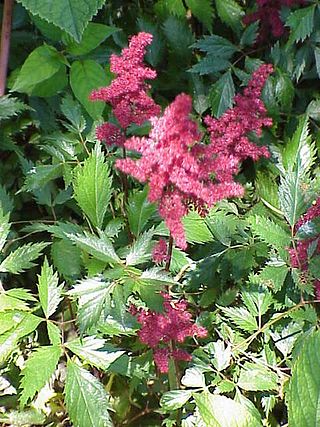
Astilbe is a genus of 18 species of rhizomatous flowering plants within the family Saxifragaceae, native to mountain ravines and woodlands in Asia and North America. Some species are known by the common names false goat's beard and false spirea.

The Sir Harold Hillier Gardens is an arboretum comprising 72 hectares accommodating over 42,000 trees and shrubs in about 12,000 taxa, notably a collection of oaks, camellia, magnolia and rhododendron.
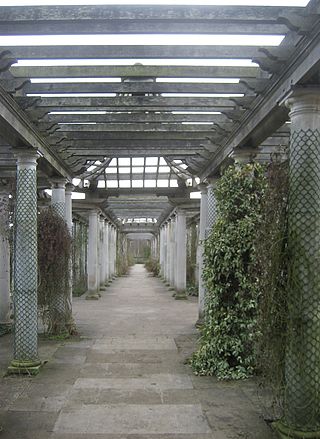
Thomas Hayton Mawson, known as T. H. Mawson, was a British garden designer, landscape architect, and town planner.

Rydal Hall is a large detached house on the outskirts of the village of Rydal, Cumbria, in the English Lake District. It has an early nineteenth-century front facade, but includes some earlier fabric.

Blackwell is a large house in the English Lake District, designed in the Arts and Crafts style by Baillie Scott. It was built in 1898–1900, as a holiday home for Sir Edward Holt, a wealthy Manchester brewer. It is near the town of Bowness-on-Windermere with views looking over Windermere and across to the Coniston Fells.

Graythwaite Hall, in Ulverston, Cumbria in the Lake District of England is the home of the Sandys family.

Hutton in the Forest is a Grade I listed country house near the village of Skelton in the historic county of Cumberland, which now forms part of the modern county of Cumbria, England. It belonged to the Fletcher-Vane family from 1605 until 1931 when it became the property of the Barons Inglewood who were distant relatives of the Fletcher-Vane family.
Longstock Park is in the civil parish of Longstock in the Test Valley district of Hampshire, England, and forms part of the Leckford Estate, wholly owned by the John Lewis Partnership.
John Graefer or Johann Andreas Graeffer was a German botanist nurseryman born in Helmstedt. Graeffer/Graefer is remembered by garden historians as having introduced a number of exotic plants to British gardens and to have worked for the king of Naples at the palace of Caserta.

The Bannisdale Horseshoe is an upland area in Cumbria, England, near the eastern boundary of the Lake District National Park, surrounding the valley of Bannisdale Beck, a tributary of the River Mint. It is described in the final chapter of Wainwright's book The Outlying Fells of Lakeland.

Dalemain is a country house around 5 miles south-west of Penrith in Cumbria, England. It is a Grade I listed building. Dalemain is part of the Lake District UNESCO World Heritage Site.

The Field Elm cultivar Ulmus minor 'Dicksonii', commonly known as Dickson's Golden Elm, is a yellow-leaved tree raised in Chester in 1900 by Dickson's Nursery, which distributed it from the autumn of 1907 as 'Golden Cornish Elm'. 'Cornish Elm' was the name often given in error to Guernsey or Wheatley Elm by the local authorities who planted the latter extensively, an error which may have influenced the choice of name by Dickson's nursery. 'Dicksonii' is usually listed as a variety of Guernsey Elm rather than Cornish Elm, Bean giving 'Wheatleyi Aurea' as a synonym, and Hillier 'Sarniensis Aurea' and later U. × sarniensis 'Dicksonii'. Clibrans' nursery of Altrincham, however, described it (1922) as otherwise identical "in habit and constitution" to 'type' Cornish Elm. The Späth nursery of Berlin distributed it from c.1913 as U. campestris cornubiensis Dicksonii. The nursery Messieurs Otin père et fils of Saint-Étienne sold an Ulmus Wheatleyi aurea pyramidalis, with leaves marbled yellow, in 1882, earlier than Dickson's introduction.





















